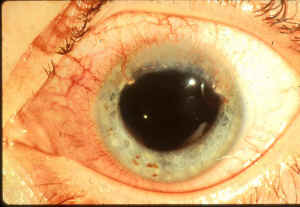Keratoconjunctivitis sicca
Keratoconjunctivitis sicca ( dry eye syndrome or even wetting disorders;. Engl dry eye syndrome ) refers to the clinical picture of dry eye. If that occurs in this syndrome lack of tear secretion ( hypovolemic form) and / or changes in the composition of the tear fluid not treated, the causative inflammatory processes can strengthen the eye in a retroactive effect and to different symptomatic complaints such as redness, burning sensation of the eye, accompanied foreign body sensation, lead. From the hypovolemic separating the hyperevaporative form, usually caused by inflammation or atrophy of the meibomian glands. Here, the thin lipid layer of the tear film is changed, which leads to increased evaporation of the aqueous tears and thus dehydration. Both forms lead to hyperosmolarity of the tear film, which self-perpetuating inflammatory processes is the basis for the.
If the syndrome is not treated, it can in addition to some very unpleasant and associated with a drastic reduction in the quality of life of symptomatic complaints lead to a constant escalation of the inflammatory processes in the eye.
The disease first described in the 1950s, the Swedish ophthalmologist Henrik Sjögren.
Causes
- VDU (Office Eye Syndrome, Gamer Eye for computer players )
- Environmental impacts
- Contact lenses
- Low humidity / air conditioning
- Hormonal changes, such as testosterone deficiency in old age
- Drugs such as beta blockers, " pill ", or treatment with anti- androgens and androgen synthesis inhibitors, such as prostate cancer or lasting topical application of hair growth agents based on such materials.
- Eyelid inflammation ( blepharitis )
- Rosacea
- Allergies
- Autoimmune diseases (e.g. Sjögren's syndrome )
- Eye surgeries such as LASIK, cataract surgery, refractive surgery
- Rheumatoid arthritis
Imbalance of extracellular DNA and nuclease activity on the surface of the eye on the ocular surface of patients with keratoconjunctivitis sicca (Dry Eye Disease (DED ) ) can be found in the mucoid film extracellular DNA ( eDNA ), and extranucleäres chromatin neutrophils ( NETs ) consisting of eDNA, histones, and neutrophil elastase is Cathlicidin. The nuclease activity in the tear fluid of patients DED was reduced while the amount of the EDNA was increased on the eye surface. One can conclude that the production of extracellular DNA and its clearance mechanisms are dysregulated in patients with DED. Currently, the hypothesis is tested that Nukleasedefizienz in the tear fluid allows the accumulation of eDNA and NETs in the pre-corneal tear film contributes to inflammation of the ocular surface.
Frequency
Dry eye is one of the most common diseases in the field of ophthalmology, the prevalence increases with age.
Diagnostics
- Clinical signs, such as abnormalities of the tear film of the cornea and
- Determination of tear film breakup time ( BUT even after break- up time) and thus the stability of the tear film
- Staining of defects in conjunctiva and cornea with fluorescein
- Staining of devitalized, but still intact cells, with rose bengal or lissamine green
- Schirmer test with insert a filter paper to determine the Tränensekretionsmenge
- In severe or refractory cases, where appropriate through investigation, including hormonal status, determination of rheumatoid factors, conjunctival smear
Treatment options
The treatment of dry eye is usually done by an improvement of the tear film at the same time appropriate local and systemic treatment of any underlying diseases ( blepharitis, Sjögren's syndrome, etc. )
- In the hypovolemic Form: Replacement / addition of artificial tears the aqueous phase of the tear fluid (artificial tears in the form of eye drops are instilled into the open eye or introduced as eye gel in the conjunctival sac of the eye ). They consist of aqueous solutions of thickening agents (such as povidone, hydroxypropyl methylcellulose, carboxymethylcellulose ), salts and optionally other ingredients (e.g., hyaluronic acid, panthenol ). To prevent allergies are preparations without preservatives available.
- When hyperevaporativen shape: improving meibomian gland function (eg by Lidrandhygiene ) and complement the superficial lipid layer of the tear film by lipid-containing tear substitutes or liposomal eye spray ( sprayed on the closed eyes, reached over the edges of the lids the tear film and stabilizes the lipid layer ).
- Replacement of the tear film and reduce the shear forces between the eye surface and eyelid at the Lidbewegungen by fatty ointments ( O / W emulsions). Are often used in the treatment of dry eye in the night.
- Insertion of punctal plugs in one or both puncta lacrimalia. The plugs can permanently remain in the puncta or dissolve after a few weeks depending on the version. Cons: The retention of tear fluid means but at the same time that the pro-inflammatory substances in the tear fluid, which has an altered composition in dry eye longer remain on the eye. The reduced through the plugs outflow of tears by the lacrimal drainage system can infections caused by bacteria that ascend from the nasal cavity, abet.
Further therapies try, in appropriate cases, to suppress on the improvement of the tear film, the underlying inflammatory processes in the eye.
- Cyclosporin A solution (trade name Restasis 0.05 %, aqueous suspension, approved U.S. only) or oily solution (0.05% in vegetable oil, in-house production of the German pharmacy )
- Autologous serum ( 2007 several German university eye clinics in testing )
- Androgens ( external use on the eyelid; currently in Phase IIb trials in the U.S. ). This therapeutic approach accesses the knowledge that the inflammatory processes are highly androgen dependent. Also, androgens on the eye inflammation.










